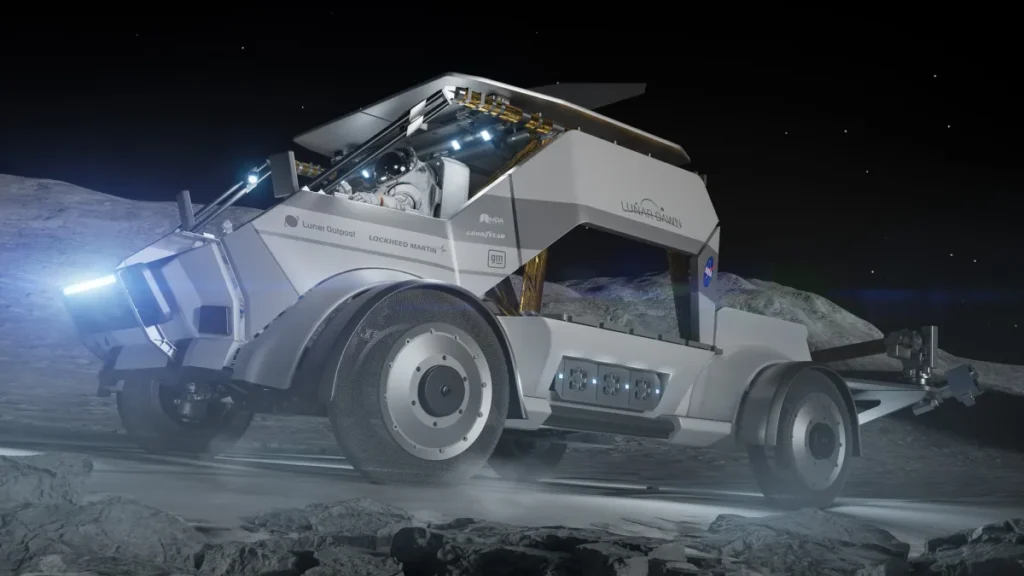NASA, Artemis program, lunar rover, Intuitive Machines, Lunar Outpost, Venturi Astrolab, lunar exploration, space technology, moon missions, commercial spaceflight
“NASA has selected Intuitive Machines, Lunar Outpost, and Venturi Astrolab to develop lunar rover concepts for the Artemis program, aiming to enhance lunar exploration and scientific research. These companies will design rovers for future Artemis missions, integrating innovative technologies to navigate the moon’s terrain and conduct scientific investigations.”

NASA has embarked on a groundbreaking journey with the selection of three companies to develop lunar rover concepts for its Artemis lunar missions. This initiative, announced on April 3, underscores NASA’s commitment to advancing lunar exploration and scientific research. The chosen companies, Intuitive Machines, Lunar Outpost, and Venturi Astrolab, are tasked with designing rovers for use in the Artemis missions, starting with Artemis 5, slated for the end of this decade. These rovers will be provided to NASA as a service, akin to the agency’s procurement of spacesuits and lunar landers.
The Lunar Terrain Vehicle (LTV) Services contract signifies a major step in NASA’s Artemis program, aiming to facilitate astronaut transportation across the moon’s surface and enable scientific exploration. Vanessa Wyche, director of NASA’s Johnson Space Center, highlighted the vision for the LTV as a fusion of Apollo-era lunar rovers and modern uncrewed mobile science platforms. This hybrid approach allows for both manned exploration and remote scientific investigations, enhancing the scope and depth of lunar research.
Intuitive Machines is at the forefront with its Moon RACER (Reusable Autonomous Crewed Exploration Rover) project, collaborating with notable entities like AVL, Michelin, Boeing, and Northrop Grumman. The rover will be transported via Intuitive Machines’ Nova-D lander, an advanced version of its Nova-C lander that successfully reached the moon earlier. This collaboration underscores the integration of automotive and aerospace expertise in developing sophisticated lunar exploration technologies.
Lunar Outpost, a burgeoning startup, leads the Lunar Dawn team, partnering with Lockheed Martin, MDA Space, General Motors, and Goodyear. This consortium blends aerospace design, robotics, automotive technology, and tire engineering to craft a rover that meets the rigorous demands of lunar terrain and exploration activities.
Venturi Astrolab’s contribution to this endeavor is the FLEX rover, with plans to launch a robotic version to the moon aboard a SpaceX Starship mission by late 2026. In collaboration with Axiom Space and Odyssey Space Research, Astrolab is poised to exceed NASA’s requirements with its innovative rover design.
The companies remain reticent on detailed technical specifications, indicating ongoing development and design refinement. However, the existing prototypes and extensive experience in related technologies promise innovative solutions that will meet, if not surpass, NASA’s stringent requirements.
The LTV Services contract, potentially worth $4.6 billion over 15 years, is currently in a “feasibility phase,” with the awarded companies focusing on advancing their rover designs to preliminary design reviews. The next phase will involve a “demonstration” task order, leading to the final rover development and deployment to the moon’s south polar region for testing before Artemis 5’s arrival.
NASA’s strategy emphasizes a competitive approach, fostering innovation and efficiency. The agency plans to eventually select one company for the demonstration task order, followed by annual procurement of LTV services for both crewed and uncrewed missions. This approach mirrors NASA’s broader adoption of commercial partnerships, promoting a vibrant and competitive space industry.
The potential for commercial opportunities beyond NASA’s immediate needs is a significant aspect of the LTV initiative. The agency envisions a gradual transition to a market-driven model, with the private sector playing an increasing role in lunar exploration. This vision not only enhances the sustainability of lunar missions but also opens new horizons for commercial enterprises in space exploration.
The LTV program is a testament to NASA’s forward-thinking approach, blending government and commercial efforts to advance lunar exploration. As these rovers traverse the lunar landscape, they will not only support scientific and exploratory missions but also pave the way for a new era of lunar and potentially interplanetary exploration. The collaboration between NASA and these pioneering companies marks a significant milestone in humanity’s quest to explore and understand our celestial neighbors.
Read More-
- Nasa Snake Robot- Revolutionizing the Search for Life on Enceladus
- Unveiling the First Instruments for Artemis Moon Mission
- Nasa Snake Robot- Revolutionizing the Search for Life on Enceladus
- NASAs Select Terrain Vehicle for Artemis Missions










